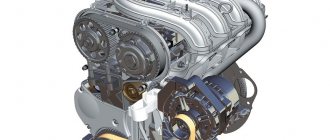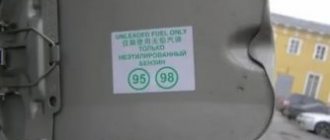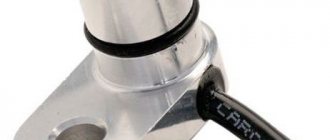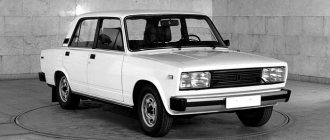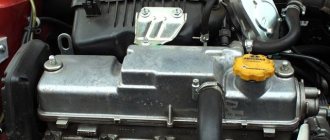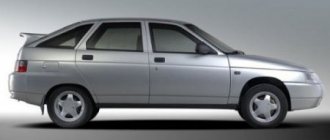Engine VAZ 11183-50
The 183-50 engine was installed on the first Kalina; it was one of the first internal combustion engines with an injector. A huge advantage of this engine is that it does not bend the valve if the timing belt breaks. The engine is equipped with 8 valves, which affects the noise of its operation, as well as a fairly frequent procedure for adjusting the valve clearance.
Specifications
Advantages and disadvantages
Pros:
- No bending of the valves when the belt breaks;
Minuses:
- Need for valve adjustment
- Low engine power;
- Outdated components;
- Noisy operation;
Transmission Lada Kalina 2
Quite recently it became known that new models will be equipped with manual transmissions of a new type. The operation of the gearbox with engines 21116 and 21126 is currently being tested, and we know that the gearbox will have a cable drive to ensure easy shifting and partial elimination of vibration on the lever.
Moreover, the cars will receive automatic transmissions from the Japanese company Jatco. Although this automatic transmission is not new, it has already shown itself well in Nissan cars. The box has 4 gears, and forced engagement of only 1 or 1 and 2 gears. This machine is already installed on Lada Granta cars of the “norm” and “luxury” trim levels.
Engine VAZ 11186
This engine replaced the 11183 internal combustion engine. Distinctive features of this engine are a lightweight cylinder-piston group and connecting rods. Also in the engine, the compression ratio was increased by reducing the recesses for the valves, therefore, this led to bending of the valves when the timing belt breaks.
Specifications
Advantages and disadvantages
Pros:
- Increased compression ratio;
- More modern components;
Minuses:
- Noisy operation;
- Bend valves when the belt breaks;
- The need to adjust the valves;
Description of main faults
On Kalina, with regard to power units, there are a number of constant malfunctions. Why are they considered permanent? Most likely, this is due to design flaws that the designers cannot correct. So, let's look at which faults are more common than others.
The engine gets hot
The cause of this phenomenon is often the thermostat. As everyone knows, this is a common occurrence on cars produced by AvtoVAZ, starting with the “Classics”. To eliminate the problem, you need to replace the thermostat with a new one. But what to do if the reason is not in it, and the engine was heating up for another reason? It is worth determining why this is so and what the reasons are.
- Temperature sensor malfunction.
- The cooling fan has failed.
- Faulty wiring or electronic engine control unit.
Failure to comply with the temperature regime can lead to engine malfunction, and will also lead to significant malfunctions of the cylinder head and cylinder block. It is worth remembering that the recommended operating temperature of the Kalina engine is 87-103 degrees Celsius.
To ensure that the car does not heat up above the recommended values, it is necessary to check whether the cooling system and other related components are working properly.
Engine VAZ 21126
This engine is equipped with two camshafts and 16 valves. Compared to 8-valve engines, there is increased power and quieter operation of the internal combustion engine. The engine is equipped with hydraulic compensators that automatically adjust the valves, but often during a cold start they make a knocking noise that goes away as the engine warms up.
Specifications
Advantages and disadvantages
Pros:
- More dynamic characteristics;
- The torque is noticeably greater;
Minuses:
- Bend valves when belt breaks
- Demanding on the quality of oil;
- Knock of hydraulic compensators when cold;
Summing up
It is quite difficult to unequivocally answer the question which engine is better.
If you are interested in power, quick acceleration and quiet driving, then it is better to choose a 16-valve engine. It consumes less gasoline and does not require valve adjustments.
If low maintenance and unpretentiousness are important to you, then your choice is an 8-valve engine . This option is better suited for those motorists who prefer to maintain and repair their car themselves.
Engine VAZ 21127
The most modern engine installed in serial Kalinas. The engine received a more modern intake receiver with modified geometry. This modification made it possible to increase the technical characteristics of the engine. The outdated mass air flow sensor was replaced by an absolute pressure sensor, which made it possible to forget about floating engine speeds forever.
Specifications
Advantages and disadvantages
Pros:
- High speed;
- Lack of mass air flow sensor;
Minuses:
- Bend valves when the timing belt breaks;
Maintenance
According to AvtoVAZ recommendations, the 11183 engine must be serviced according to the regulations:
| Oil consumption | 0.5 l/1000 km |
| Engine oil for 11183 | 5W-30 and 10W-40 |
| Engine oil volume | 3.5 l |
| Operating temperature | 95° |
| Motor life | declared 150,000 km, |
| Adjustment of valves | washers between camshaft cams and tappets |
| Cooling system | forced, antifreeze/antifreeze |
| water pump | plastic impeller |
| Candles for 11183 | BPR6ES, A17DVRM |
| Gap between spark plug electrodes | 1.1 mm |
| Timing belt | Gates |
| Cylinder operating order | 1-3-4-2 |
| Air filter | Nitto, Knecht, Fram, WIX, Hengst |
| Oil filter | catalog number 90915-10001 |
| Flywheel | from 2110 |
| Valve stem seals | code 90913-02090 light inlet |
| Compression | cylinder pressure from 13 bar nominal |
| XX speed | 800 – 850 min -1 |
| Tightening force of threaded connections | spark plug – 18 Nm |
| Maintenance object | Time (month) or mileage (10,000 km) |
which comes first
Engine Kalina Sport
Kalina Sport received a VAZ 21126-77 engine. This engine is highly boosted with increased power and torque. From the attachments on the engine, the intake receiver and direct-flow muffler have changed. A camshaft with modified cams made it possible to change the valve timing.
ICE characteristics
Advantages and disadvantages
Pros:
- High speed;
- Powerful engine;
Minuses:
- Bend valves when the belt breaks;
- Small resource;
- High fuel consumption;
Advantages and disadvantages
The advantage of the 11183 engine is the cylinder head of the original design. However, it was subsequently further modified into the ICE 11186, adding volume to the combustion chambers. The downside is the generator belt tensioner - the drive is constantly over-tightened, a deflection of 10 mm is not ensured without slipping, so the belt life is reduced and it has to be changed more often. This defect was corrected only in the next version of the motor 11186.
The integrated catalytic collector assembly in the engine was initially unfinished:
- the tubes of the four channels are short;
- flows converge inside the block at almost one point;
- exhausts collide and create opposition to each other;
- the shape of the block did not allow changing the arrangement of the tubes.
When installing the engine on the Lada Granta, the cabin heat exchanger was connected to the thermostat in series. All the coolant passed through it along a small circuit, the response temperature error was 5 degrees instead of the required 2 degrees.
Kalina NFR engine
Kalina with the NFR prefix is equipped with the most powerful engine installed in the Lada, VAZ 21126-81. The NFR has the same engine as the sport modification, but more powerful. Sports camshafts, intake and exhaust manifolds gave the engine more agility and playfulness.
ICE characteristics
Advantages and disadvantages
Pros:
- High speed;
- High torque;
- Powerful engine;
Minuses:
- Bend valves when the belt breaks;
- Small resource;
- High fuel consumption;
Technical Standards and Troubleshooting
All power units of the Lada Kalina are installed together with a 5-speed manual transmission. For the 8-valve Kalina engine, an oil change is provided after 15,000 km. The timing belt, according to technical documentation, should be replaced every 60,000 km. But in order not to run the risk of replacing the belt in the field, it is recommended to change it every 50,000 miles.
In general, chronic deficiencies do not need to be eliminated, but, as with any mechanism, breakdowns are inevitable. As practice shows, any part can fail. From the cylinder head to the offset of the liners. The 16-valve Kalina engine often has problems with the gearbox. Its technical capabilities reach zero after a mileage of about 100,000 km.
When passing the 25-30 thousand km mark, special attention should be paid to the clutch disc. More than 60% of owners replace it during this period. If your family budget allows it, then it is best to install an imported analogue. In 95% of cases, it will last much longer than its original VAZ.
If the Lada Kalina was purchased secondhand, then it is necessary to check the entire engine compartment. It is necessary to make sure that the compression is uniform in all cylinders in the Kalina engine. Otherwise, the protection of the power unit may be at risk. The steering rack should also be checked. This is Kalina’s weak point; such a “chronic disease” is inherent in cars produced before 2006.
One of the signals to seriously think about repairs (possibly overhaul) in the Kalina engine is the exponentially increasing oil consumption. This can happen either at 40 or 140 thousand km. More than half a liter of oil per 1000 km is a critical signal.
Be prepared that the cost of repairs may approach 20,000 rubles. The main elements that require replacement and repair may be: the piston camshaft (the clearance may already be critical), the cylinder block (boring will be required). Changing the engine oil yourself will help you save a lot of money. To do this you need to complete 6 steps.
- We warm up the engine to operating temperature, soot and sludge will be better washed out.
- We put the car on the handbrake and determine where the drain plug points.
- Drain the engine oil and replace the oil filter.
- Install a new filter.
- Pour in new oil and check the level.
- We make a test drive and check the level again.
Tuning
Engine tuning is most often carried out in order to increase the power above that indicated in the passport. On a VAZ 11183 engine, it can be increased without special costs through a number of sequential operations:
- Increase engine power to 90 hp. With. It is possible if you replace the existing camshaft with “OKB Dinamika 108” or “Nuzhdin 10.93” and install a split gear. With the correct phase settings, the power unit can develop power up to 90 hp. With.
- By installing a receiver, an enlarged 54 mm throttle body and a Spider 4-2-1 exhaust, you can increase the engine power to 100 hp. With.
- After modification of the cylinder head and intake manifold, the engine power will increase to 115 hp. With. True, for this it is necessary to replace the standard valves with lighter ones (T-shaped).
- By replacing the piston group with a lighter one (for example, from a LADA Priora car), we get a power of more than 120 hp. With.
The same result can be obtained if you install on the engine:
- compressor PK-23-1;
- camshaft “Nuzhdin 10.42” or “Nuzhdin 10.63”.
The power of the 8-valve power unit can be further increased, but this will lead to a significant reduction in its service life.
About engines for LADA Kalina
A small family of AvtoVAZ cars, Lada Kalina, appeared in 2008 and includes a sedan, station wagon and hatchback. The model was created on the basis of the VAZ 2108 and many units, including engines, were borrowed from it.
Engine VAZ 21114/11183 1.6l (2114 1.6)
The VAZ 21114/11183 power unit became an evolutionary development of the 1.5-liter 2111 engine, but with an oversized cylinder block and an increased piston stroke, due to which the volume of the entire engine increased to 1.6 liters.
The new engine has increased eco-standards, and can also be called reliable and unpretentious, unlike the base 2111. Benefits in terms of traction and elasticity have been noted.
The engine is recognized under several names: 21114, 11183, 2114 and motor-Kalina, but the difference is only in the place of assembly.
The VAZ 21114/11183 four-cylinder in-line injection engine received an overhead camshaft and a timing belt drive.
The lack of hydraulic compensators forces the valves to be periodically adjusted.
If the belt breaks, the valve does not bend; in the sports version of the camshaft there is such a chance.
The disadvantages are generally the same as those of the VAZ 2111, that is, the same noise and diesel engine, tripping, temperature instability, etc. 3
Engine VAZ 11194 1.4 16V
The VAZ 11194 power unit with 16 valves became a simplified version of the Priora engine and an evolution of the VA 21083 in a modified version.
Unlike the base engine, the VAZ 11194 1.4 16V differs in volume, power and worse torque.
The engine life has increased by 50 thousand kilometers compared to its predecessors and reaches 200 thousand km.
In the technical part, the pistons have changed, decreasing in diameter to 76.5 mm, which made it possible to reduce the volume of the engine and combustion chamber. This idea of transformation led to the fact that the torque at the bottom disappeared and the engine starts only from 2000 rpm and requires constant torque.
When the timing belt breaks, the valves bend, the rollers fall apart, and if the pump jams, the timing belt falls off, which leads to expensive repairs.
The VAZ 11194 is not without various noises and knocks, problems with temperature, floating speed and other things. To date, the VAZ 11194 1.4 16V engine has been discontinued. 2
Engine Priora 21126 1.6 16 valves
The 21126 power unit was a continuation of the VAZ 21124, but with a lighter Federal Mogul SPG. The valve wells have become smaller, and the timing belt drive has received an electric tensioner. The cylinder block is surface-finished and honed to Federal Mogul's strict standards.
The 21126 1.6 4-cylinder injection engine received an overhead camshaft and a belt timing mechanism.
The disadvantages of the engine include loss of power, unstable operation and a problematic timing belt. The culprits of such malfunctions are defects in fuel pressure, poor timing, defects in sensors, throttle valve and air pumping with hoses.
When the timing belt breaks, the valves bend.
Loss of performance is detected when compression in the cylinders is low.
Floating speed can be corrected by cleaning the throttle valve or replacing the throttle position sensor.
Noise and knocking are typical for all VAZ engines and the problems lie in hydraulic compensators, connecting rod and main bearings or pistons.
Engine vibrations occur due to defects in high-voltage wires or IAC.
With all its shortcomings, the Priora 21126 1.6 16 valve engine is considered one of the best Russian units for comfortable driving around the city.
Source
Specifications
| 1) module replacement | ||
| Extraneous noise | 1) misadjustment of valve clearances | |
| 1)adjustment with valve gaskets | ||
| Alternator belt break | excessive tension, manufacturing defect | Regular check, replacement as necessary |
| PARAMETER | MEANING |
| Cylinder displacement, cubic meters cm | 1.596 |
| Rated power, l. With. (at 5200 rpm) | 82 |
| Maximum torque, Nm (at 2700 rpm) | 120 |
| Number of cylinders | 4 |
| Number of valves per cylinder, pcs. | 2 |
| Total number of valves, pcs. | 8 |
| Cylinder diameter, mm | 82 |
| Piston stroke, mm | 75.6 |
| Spark plug | A17 DVRM, BPR6ES (NGK), etc. |
| Cylinder operation diagram | 1 – 3- 4- 2 |
| Supply system | Injector (electronically controlled distributed injection) |
| Fuel | Unleaded gasoline AI-92 |
| Fuel consumption, l./100 km. (city/highway) | 8,8/5,7 |
| Lubrication system | Combined (spraying + under pressure) |
| Engine oil type | 5W-30, 5W-40, 10w-30 and 10W-40 |
| Engine oil quantity, l | 3.5 |
| Cooling system | Liquid, closed type |
| Coolant | Based on ethylene glycol |
| Motor resource, thousand hours. (theory/practice) | 150/300 |
| Weight, kg | 127 |
Malfunctions: causes, elimination
In operation, motor 11194 showed its worst side, as it “inherited” all the faults of previous versions, and added its own problems to users:
| Valve bend | Timing belt is torn or fallen off | periodically check the belt or replace it |
| Extraneous sounds | knocking of pistons, bearings, valves | replacement with repair kit |
| Overheat | failure of the pump, thermostat | installation of new units |
| the engine stalls or the speed fluctuates | malfunction of the sensors TPS, DXX | repair or purchase of new sensors |
| increased consumption of gasoline and oil | misadjustment of valves, intake tract, wear of catalytic collector, wear of rings | replacement of parts |
The cooling system in the 11194 motor is considered trouble-free, with the exception of the pump with a polymer impeller. Despite the fact that the internal combustion engine has been discontinued, components for it are produced by AvtoVAZ and Federal Mogul.



